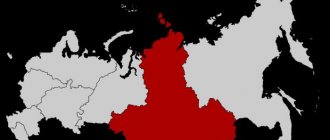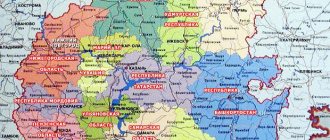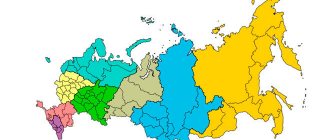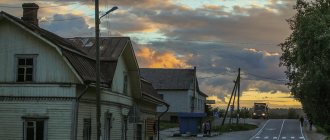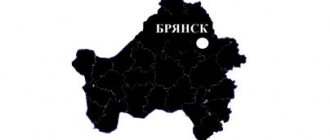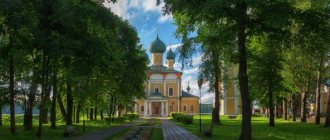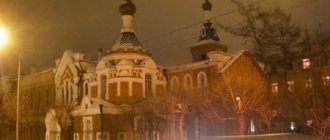The center of the Siberian Federal District is Novosibirsk. What other region of Russia can compare with it in terms of the size of the territory included in it? It is second only to the Far Eastern District. It consists of regions, territories and republics. The total number of subjects is 12, the territory makes up a third of Russia. Its borders extend both by land and by sea.
Founding of Novosibirsk
Novosibirsk is a city with a population of one million in Russia. It ranks third in terms of population (1,602.9 thousand people). The largest city in Siberia, the center of the region, the federal district of Russia is Novosibirsk. What significance does it play in the history of the country? First of all, it is the largest industrial, scientific and cultural center, which has a huge impact on the development of the region and the country.
Until 1925, the city was called Novo-Nikolaevsk; it was built on the site of the village of Krivoshchekovskie settlements, located on the right bank of the Ob River. Before this, the village of Krivoshchekovo was located on the left bank, but the Great Siberian Road, which later became known as the Trans-Siberian Railway, was laid across its territory.
(adsbygoogle = window.adsbygoogle || []).push({});
It was with the construction of the railway that the history of the formation of Novosibirsk, which is part of the Siberian Federal District, began. But this is today, and in those days it could have remained a railway station, like many others along the entire length of the road. But, as always, chance intervened.
Novosibirsk region
The Novosibirsk region belongs to the West Siberian economic region and the Siberian Federal District. The region includes 5 urban districts, 30 municipal districts and 455 municipal settlements.
Date of formation of the Novosibirsk region - September 28, 1937.
Geographical conditions.
The Novosibirsk region is located in the southeastern part of the West Siberian Plain, mainly in the interfluve of the Ob and Irtysh (southern part of the Vasyugan Plain of the Baraba Lowland), in the east it adjoins the Salair Ridge.
In the north it borders with the Tomsk region, in the southwest - with Kazakhstan, in the west - with the Omsk region, in the south - with the Altai Territory, in the east - with the Kemerovo region. The main rivers
are Ob and Om. The dam of the Novosibirsk hydroelectric power station formed the Novosibirsk reservoir (the so-called “Ob Sea”). Also in the region there are about 3 thousand freshwater, salt and bitter-salt lakes (Chany, Ubinskoye, Sartlan, etc.). The north and north-west of the region is occupied by the southern part of the world's largest Vasyugan swamp.
Square
— 177.8 thousand sq.
km, or 1.1% of the territory of Russia. The length
from west to east is 642 km, from north to south – 444 km.
Population
. The population of the region according to the State Statistics Committee of Russia is 2,793,384 people. (2019). Population density - 15.71 people/km² (2019). Urban population - 78.91% (2018).
According to the 2010 All-Russian Population Census (people):
Russians - 2,365,845 Germans - 30,924 Tatars - 24,158 Ukrainians - 22,098 Uzbeks - 12,655 Kazakhs - 10,705 Tajiks - 10,054 Armenians - 9,508 Azerbaijanis - 8,008 Kyrgyz - 6,506 Belarusians - 5,382
Nationality data was obtained from 2,541,052 individuals. 124,859 people either the information is missing or not specified.
Novosibirsk is the third most populous city in Russia, the largest municipal entity in the Russian Federation with a permanent population of 1,618,039 people. (2019), which is more than 50% of the population of the Novosibirsk region.
Climate
The Novosibirsk region is sharply continental. Average January temperature: from −16 in the south to −20 °C in the northern regions. Average temperature in July: +18…+20 °C. Average annual air temperature: 0.2 °C.
Minerals.
In total, on the territory of the Novosibirsk region there are 523 deposits of various minerals, of which 83 are currently being exploited. In the region, reserves of such minerals as hard coal have been explored (the Gorlovka basin, where high-quality anthracite is mined, proven reserves are 905 million tons, projected about 5.6 billion tons, as well as the Zavyalovskoye deposit of Kuzbass with coking coal reserves of more than 50 million tons), refractory clay, peat. Oil and natural gas fields have been discovered in the north-west of the region. In the Northern region of the region, 7 oil fields have been discovered (Verkh-Tarskoye, Maloichskoye, Vostochno-Tarskoye, Tai-Dasskoye, Rakitinskoye, Vostochnoye and Vostochno-Mezhovskoye) and one gas condensate field - Veselovskoye. Oil quality is close to Brent. The average depth of productive formations is about 2500 m. The largest is the Verkh-Tarskoye field. Taking into account previously estimated reserves, it contains about 60% of all oil reserves in the region. The remaining deposits are small. Verkh-Tarskoye and Maloichskoye - production is about 2 million tons per year, the rest are mothballed. Proven oil reserves amount to ≈ 43 million tons, predicted - 113 million tons, however, oil and gas fields are gradually being decommissioned. Peat reserves are estimated at 7.2 billion tons, but due to the high costs of its extraction and processing, there is practically no development of peat deposits. A large deposit of non-ferrous metal ores - titanium dioxide (≈ 1.7 million tons) and zirconium dioxide (≈ 7.2 million tons) - was discovered in the region. Industrial reserves of gold in the Novosibirsk region are small and are estimated at 17 tons. One ore and 24 placer deposits have been explored. 4 marble deposits have been discovered with reserves of more than 8.5 million m³, and the marble of two of them is highly decorative and is in high demand. There are significant resources of underground fresh, thermal and mineral waters. More than half a million cubic meters of water are extracted daily from 9.5 thousand wells. The total area of the forest fund of the Novosibirsk region is about 4,490,000 hectares, including the area occupied by coniferous species - 977,300 hectares (21.76%). The total wood supply of the main forest-forming species is estimated at 278,800,000 m³.
Industry
The leading industry in the Novosibirsk region is mechanical engineering and metalworking (electrical equipment, instrument making, metallurgical equipment). Ferrous and non-ferrous metallurgy are also developed
Agriculture
Agriculture in the region specializes in growing grain, potatoes and vegetables. Meat and dairy farming, poultry farming and beekeeping are developed. Flax production plays an important role. The Novosibirsk region accounts for a quarter of all agricultural land in Western Siberia.
Foreign economic activity
International relations of the Novosibirsk region in trade, economic, investment, scientific, technical, cultural, educational and other spheres are expanding every year. Foreign trade operations are carried out with partners from 110 countries near and far abroad. Foreign trade operations are carried out with partners from 86 countries of the near and far abroad, while 73.7% of the value of foreign trade turnover is accounted for by trade with China, Ukraine, Kazakhstan, Germany, Bulgaria, and the USA.
Transport
There are 11 airports in the region, Tolmachevo Airport is an international airport of federal significance. The operational length of public railway tracks (West Siberian Railway) is 1530 km. Federal highways M51, M52, M53, as well as highways P380 and P384 pass through the region.
Science and education
In the region, 47 universities provide higher education to the population. Novosibirsk Academic Town hosts dozens of research institutes, Novosibirsk State University, NSU School of Physics and Mathematics, and the Institute for Research in Circulatory Pathology. Not far from Novosibirsk, in the science city of Koltsovo, there is the State Scientific Center for Virology and Biotechnology “Vector”. The Siberian branch of the Russian Academy of Agricultural Sciences is located in the village of Krasnoobsk. There are a large number of libraries in Novosibirsk, the largest of which are the State Public Scientific and Technical Library of the SB RAS (SPNTL SB RAS) and the Novosibirsk State Regional Scientific Library (NSRL).
Culture
The regional center of the Novosibirsk region is Novosibirsk, which is rightfully considered one of the recognized cultural centers of Russia and the cultural center of Siberia. There are 11 theaters here, the most famous of which is the Novosibirsk State Academic Opera and Ballet Theater, which is a historical and architectural symbol and a calling card not only of Novosibirsk, but of Siberia as a whole. The Novosibirsk Philharmonic and the Glinka State Conservatory have received international recognition. Since 1966, the largest State Public Scientific and Technical Library of the SB RAS in Siberia has been operating in Novosibirsk.
The cultural attractions of the city include the Novosibirsk Zoo, located on the territory of the Zaeltsovsky Forest Park. The location in a pine forest is a unique case among all zoos in the world. It contains about 10,000 individuals of 702 species of animals. More than 300 species are listed in the International Red Book, the Red Book of Russia and the Novosibirsk region. Animals are kept in spacious enclosures and often give birth. The zoo has one of the world's richest collections of cats and martens. Some species (argali, lion tamarin, takin and some others) are no longer kept in any of the zoos in Russia and the CIS. There are no individuals of the Caucasian leopard in any zoo in the world, except for Novosibirsk. Separately, it should be said about the liger - a rare hybrid of a lion and a tigress.
From Siberia to Altai
In May 1893, builders of a settlement of bridge workers arrived on the right bank, which would be built north of the village of Krivoshchekovskie settlements. After a while they will merge together and receive the single name Novo-Nikolaevsk. In ten years, the village at the Ob railway station will be awarded the title of a city without a district.
In St. Petersburg, a decision is made to connect Siberia with Altai by rail. Thanks to the efforts of the city mayor of Novo-Nikolaevsk V. Zhernakov, a decision was made to build a railway branch to the city of Semipalatinsk through Novo-Nikolaevsk in 1912. This played a major role in the development of the future of Novosibirsk, the center of the Siberian Federal District. The history of the city has changed dramatically; it is becoming a transnational transport hub.
(adsbygoogle = window.adsbygoogle || []).push({});
Novosibirsk
At the beginning of the 18th century. the village of Krivoshchekovskaya was a center of trade between the Teleuts, who inhabited the right bank of the Ob River, and the Russians, who settled on the left. The village owes its name to the nickname of the Tomsk serviceman Fyodor Krenitsyn, whose name was Krivoshchek. By the end of the 18th century, on the left bank of the Ob in the area of modern Novosibirsk there were several Russian villages and hamlets (Bolshoye and Maloye Krivoshchekovo, Bugrinskoye, Eresnaya, etc.). On the right bank in the area of modern Novosibirsk there were the Krivoshchekovsky settlement, the villages of Eltsovka, Ust-Inya, Kamenka, etc. In 1893, a settlement for builders of the railway bridge across the Ob was founded. On April 30, 1893, the first batch of bridge builders arrived from Kolyvan, and this date is considered to be the founding day of Novosibirsk. A working village grew up near the mouth of the Kamenka River, and to the north of it the Ob railway station with a station village was built.
Soon both villages united under the common name Alexandrovsky. On February 17, 1898, the village was renamed Novonikolaevsky, and on December 28, 1903, by the highest command of Emperor Nicholas II, the settlement at the Ob station received the status of a county-free city with the name Novonikolaevsk.
In 1912, universal primary education was officially introduced in Novonikolaevsk (all children who wanted to could go to school). The main event that determined the future fate of the city occurred on July 3, 1912. On this day, the project for the construction of a railway connecting Novonikolaevsk and Semipalatinsk (now the city of Semey in Kazakhstan) was approved by the highest authorities.
Novonikolaevsk presented itself as the geographical center of the empire, this fact was symbolized in 1914 by the construction of the chapel of St. Nicholas in the city. By 1915, the city's population reached 70 thousand people, and there were 7 banks in Novonikolaevsk. On April 17, 1917, Novonikolaevsk became a district town of the Tomsk province.
The years of revolution and civil war plunged the city into chaos and famine. The improvement of the city's position began with a resolution of the All-Russian Central Executive Committee of the RSFSR dated June 13, 1921, according to which Novonikolaevsk became the center of the province of the same name.
On May 25, 1925, a new administrative structure was created in the RSFSR - the Siberian Territory, the capital of which became Novonikolaevsk. On November 17, 1925, by resolution of the Central Executive Committee of the USSR, the city of Novonikolaevsk was renamed Novosibirsk.
Until 1930, Novosibirsk was located on the right bank of the Ob. This year, the villages of Bolshoye Krivoshchekovo and Bugry received the status of Zaobsky district and became part of Novosibirsk. On July 30, 1930, by resolution of the All-Russian Central Executive Committee, the West Siberian Territory was formed, consisting of 14 districts of the Siberian Territory and the Oirot (Gorno-Altai) Autonomous Region with its center in Novosibirsk.
In 1936, Aviation Industry Enterprise No. 153 was formed on the base. The world's first plant for the production of fighter aircraft since 1939 became the plant named after Valery Chkalov.
On September 28, 1937, by a resolution of the Central Executive Committee of the USSR, the Novosibirsk region with its center in Novosibirsk was separated from the West Siberian Territory. On January 26, 1943, the Kemerovo region was separated from the Novosibirsk region, and on August 13, 1944, the Tomsk region was separated.
The most important milestone in the formation of Novosibirsk as an industrial, scientific and cultural center of Siberia was the years of the Great Patriotic War. Many enterprises were evacuated to the city, Novosibirsk received about 130 thousand residents of besieged Leningrad. On September 21, 1943, by decree of the Council of People's Commissars of the USSR, the West Siberian Branch of the USSR Academy of Sciences was opened in Novosibirsk.
On September 25, 1948, secret enterprise No. 80 (chemical concentrate plant) was founded on the northern outskirts of Novosibirsk, producing uranium products. In 1957, the Siberian Branch of the USSR Academy of Sciences was opened in the city, and since January 18, 1959, the scientific divisions of the West Siberian Branch of the USSR Academy of Sciences were included in the Siberian Branch. On September 2, 1962, the millionth resident was officially registered in Novosibirsk. In 1969, the Siberian branch of the All-Russian Academy of Agricultural Sciences was organized in the city. On December 28, 1985, the official launch of the Novosibirsk metro took place.
On May 13, 2000, the city of Novosibirsk received the status of the center of the newly formed Siberian Federal District.
Economic boom
The decision to build a railway line to Altai and the construction that began created a real economic boom. This was the construction of the century for that time. The future flagship of the Siberian Federal District, Novosibirsk, as it appears to us in the present, was born precisely at this time. The plans of the tsarist government were to make it the capital of the Altai province in 1917. But the Kerensky government took a different path, giving preference to Barnaul.
7 banks were opened in the city. The population at that time was 70 thousand people. Housing was built, new industrial enterprises were created. Agriculture developed. The city's infrastructure was changing. A hospital and schools were opened. By the way, in 1912 the city was the first in the country, along with Yaroslavl, to declare universal primary (grade 4) education, which for a country where only every fourth resident could read and write was a huge step forward. It is not for nothing that the main city of the Siberian Federal District, Novosibirsk, as it has become today, has become a world scientific center.
General information
The Novosibirsk region belongs to the West Siberian economic region and the Siberian Federal District. The region includes 5 urban districts, 30 municipal districts and 455 municipal settlements.
Date of formation of the Novosibirsk region - September 28, 1937.
Geographical conditions.
The Novosibirsk region is located in the southeastern part of the West Siberian Plain, mainly in the interfluve of the Ob and Irtysh (southern part of the Vasyugan Plain of the Baraba Lowland), in the east it adjoins the Salair Ridge.
In the north it borders with the Tomsk region, in the southwest - with Kazakhstan, in the west - with the Omsk region, in the south - with the Altai Territory, in the east - with the Kemerovo region. The main rivers
are Ob and Om. The dam of the Novosibirsk hydroelectric power station formed the Novosibirsk reservoir (the so-called “Ob Sea”). Also in the region there are about 3 thousand freshwater, salt and bitter-salt lakes (Chany, Ubinskoye, Sartlan, etc.). The north and north-west of the region is occupied by the southern part of the world's largest Vasyugan swamp.
Square
— 177.8 thousand sq.
km, or 1.1% of the territory of Russia. The length
from west to east is 642 km, from north to south – 444 km.
Population
. The population of the region according to the State Statistics Committee of Russia is 2,798,170 people. (2020). Population density - 15.74 people/km² (2020). Urban population - 79.21% (2020).
According to the 2010 All-Russian Population Census (people):
Russians - 2,365,845 Germans - 30,924 Tatars - 24,158 Ukrainians - 22,098 Uzbeks - 12,655 Kazakhs - 10,705 Tajiks - 10,054 Armenians - 9,508 Azerbaijanis - 8,008 Kyrgyz - 6,506 Belarusians - 5,382
Nationality data was obtained from 2,541,052 individuals. 124,859 people either the information is missing or not specified.
Novosibirsk is the third most populous city in Russia, the largest municipal entity in the Russian Federation with a permanent population of 1,625,631 people. (2020), which is more than 50% of the population of the Novosibirsk region.
Climate
The Novosibirsk region is sharply continental. Average January temperature: from −16 in the south to −20 °C in the northern regions. Average temperature in July: +18…+20 °C. Average annual air temperature: 0.2 °C.
Minerals.
In total, on the territory of the Novosibirsk region there are 523 deposits of various minerals, of which 83 are currently being exploited. In the region, reserves of such minerals as hard coal have been explored (the Gorlovka basin, where high-quality anthracite is mined, proven reserves are 905 million tons, projected about 5.6 billion tons, as well as the Zavyalovskoye deposit of Kuzbass with coking coal reserves of more than 50 million tons), refractory clay, peat. Oil and natural gas fields have been discovered in the north-west of the region. In the Northern region of the region, 7 oil fields have been discovered (Verkh-Tarskoye, Maloichskoye, Vostochno-Tarskoye, Tai-Dasskoye, Rakitinskoye, Vostochnoye and Vostochno-Mezhovskoye) and one gas condensate field - Veselovskoye. Oil quality is close to Brent. The average depth of productive formations is about 2500 m. The largest is the Verkh-Tarskoye field. Taking into account previously estimated reserves, it contains about 60% of all oil reserves in the region. The remaining deposits are small. Verkh-Tarskoye and Maloichskoye - production is about 2 million tons per year, the rest are mothballed. Proven oil reserves amount to ≈ 43 million tons, predicted - 113 million tons, however, oil and gas fields are gradually being decommissioned. Peat reserves are estimated at 7.2 billion tons, but due to the high costs of its extraction and processing, there is practically no development of peat deposits. A large deposit of non-ferrous metal ores - titanium dioxide (≈ 1.7 million tons) and zirconium dioxide (≈ 7.2 million tons) - was discovered in the region. Industrial reserves of gold in the Novosibirsk region are small and are estimated at 17 tons. One ore and 24 placer deposits have been explored. 4 marble deposits have been discovered with reserves of more than 8.5 million m³, and the marble of two of them is highly decorative and is in high demand. There are significant resources of underground fresh, thermal and mineral waters. More than half a million cubic meters of water are extracted daily from 9.5 thousand wells. The total area of the forest fund of the Novosibirsk region is about 4,490,000 hectares, including the area occupied by coniferous species - 977,300 hectares (21.76%). The total wood supply of the main forest-forming species is estimated at 278,800,000 m³.
Industry
The leading industry in the Novosibirsk region is mechanical engineering and metalworking (electrical equipment, instrument making, metallurgical equipment). Ferrous and non-ferrous metallurgy are also developed
Agriculture
Agriculture in the region specializes in growing grain, potatoes and vegetables. Meat and dairy farming, poultry farming and beekeeping are developed. Flax production plays an important role. The Novosibirsk region accounts for a quarter of all agricultural land in Western Siberia.
Foreign economic activity
International relations of the Novosibirsk region in trade, economic, investment, scientific, technical, cultural, educational and other spheres are expanding every year. Foreign trade operations are carried out with partners from 110 countries near and far abroad. Foreign trade operations are carried out with partners from 86 countries of the near and far abroad, while 73.7% of the value of foreign trade turnover is accounted for by trade with China, Ukraine, Kazakhstan, Germany, Bulgaria, and the USA.
Transport
There are 11 airports in the region, Tolmachevo Airport is an international airport of federal significance. The operational length of public railway tracks (West Siberian Railway) is 1530 km. Federal highways M51, M52, M53, as well as highways P380 and P384 pass through the region.
Science and education
In the region, 47 universities provide higher education to the population. Novosibirsk Academic Town hosts dozens of research institutes, Novosibirsk State University, NSU School of Physics and Mathematics, and the Institute for Research in Circulatory Pathology. Not far from Novosibirsk, in the science city of Koltsovo, there is the State Scientific Center for Virology and Biotechnology “Vector”. The Siberian branch of the Russian Academy of Agricultural Sciences is located in the village of Krasnoobsk. There are a large number of libraries in Novosibirsk, the largest of which are the State Public Scientific and Technical Library of the SB RAS (SPNTL SB RAS) and the Novosibirsk State Regional Scientific Library (NSRL).
Culture
The regional center of the Novosibirsk region is Novosibirsk, which is rightfully considered one of the recognized cultural centers of Russia and the cultural center of Siberia. There are 11 theaters here, the most famous of which is the Novosibirsk State Academic Opera and Ballet Theater, which is a historical and architectural symbol and a calling card not only of Novosibirsk, but of Siberia as a whole. The Novosibirsk Philharmonic and the Glinka State Conservatory have received international recognition. Since 1966, the largest State Public Scientific and Technical Library of the SB RAS in Siberia has been operating in Novosibirsk.
The cultural attractions of the city include the Novosibirsk Zoo, located on the territory of the Zaeltsovsky Forest Park. The location in a pine forest is a unique case among all zoos in the world. It contains about 10,000 individuals of 702 species of animals. More than 300 species are listed in the International Red Book, the Red Book of Russia and the Novosibirsk region. Animals are kept in spacious enclosures and often give birth. The zoo has one of the world's richest collections of cats and martens. Some species (argali, lion tamarin, takin and some others) are no longer kept in any of the zoos in Russia and the CIS. There are no individuals of the Caucasian leopard in any zoo in the world, except for Novosibirsk. Separately, it should be said about the liger - a rare hybrid of a lion and a tigress.
Civil War
It was Novosibirsk, in 1917 Novo-Nikolaevsk, that was destined to become the city where the Civil War began, since historians consider it to be the beginning of the uprising of the Czechoslovak Legion. A Czech unit located in the city, together with the officer underground, overthrows Soviet power in the city. At the same time, the Siberian Autonomous Region was formed in Tomsk and a provisional Siberian government was formed. But already in November 1919, units of the Fifth Red Army liberated the Siberian regions, in which Soviet power was established.
Administrative center of the Siberian Territory
In 1920, the Bolsheviks, remembering the dominant role of Tomsk in the white movement, moved the administrative center to Novo-Nikolaevsk. But the uprising in the South-West of the Tomsk province, the siege of Novo-Nikolaevsk, its harsh suppression, and the evacuation of all administrative and party institutions to Tomsk forced the Soviet government to temporarily abandon this step.
After the civil war, the entire country lay in ruins. The inhabitants of Novo-Nikolaevsk were just over 20 thousand people. The railway did not work. The most important task was to restore the functionality of the huge transport hub. Therefore, the Bolshevik government decides to establish the Novo-Nikolaevsk province on part of the territories of the Omsk and Tomsk provinces.
var blockSettings12 = {blockId:"RA-116722-12",renderTo:"yandex_rtb_R-A-116722-12",horizontalAlign:!1,async:!0}; if(document.cookie.indexOf(“abmatch=”) >= 0){ blockSettings12 = {blockId:”RA-116722-12″,renderTo:”yandex_rtb_R-A-116722-12″,horizontalAlign:!1,statId: 7,async:!0}; } !function(a,b,c,d,e){a[c]=a[c]||[],a[c].push(function(){Ya.Context.AdvManager.render(blockSettings12) }),e=b.getElementsByTagName(“script”)[0],d=b.createElement(“script”),d.type=”text/javascript”,d.src=”//an.yandex.ru /system/context.js",d.async=!0,e.parentNode.insertBefore(d,e)}(this,this.document,"yandexContextAsyncCallbacks");
On May 25, 1925, the administrative unit of the Siberian Territory was formed, headed by the city of Novo-Nikolaevsk. This became the prototype of the status of modern Novosibirsk - the federal district, which it has had since 2000. It included the provinces: Novo-Nikolayevskaya, Tomskaya, Altaiskaya, Omskaya, Yeniseiskaya, in addition, the autonomous region - Oirotskaya, which was later included in the Altai Territory.
Siberian Federal District
Date of formation: May 13, 2000. The Siberian Federal District includes 12 subjects of the Russian Federation (since January 1, 2007, the Taimyr (Dolgano-Nenets) Autonomous Okrug and the Evenki Autonomous Okrug are part of the united Krasnoyarsk Territory. Since January 1, 2008, the Ust-Ordynsky Buryat Autonomous Okrug is part of the united Irkutsk Region. On March 1, 2008, as a result of the merger of the Chita region and the Aginsky Buryat Autonomous Okrug, the Trans-Baikal Territory was formed).
The territory of the Siberian Federal District makes up 30% of the territory of Russia, the population is 20.06 million people. The following are concentrated in Siberia: 85% of all-Russian reserves of lead and platinum, 80% of coal and molybdenum, 71% of nickel, 69% of copper, 44% of silver, 40% of gold. The gross regional product is 11.4% of Russia's GDP. The district's share in the total industrial production of the Russian Federation in 2001 was 12.4%. The share of the Siberian Federal District in the total length of Russian railways is 17.5%.
general characteristics
Date of formation : May 13, 2000.
Composition of the Siberian Federal District
12 constituent entities of the Russian Federation, including:
- 4 republics (Altai, Buryatia, Tyva, Khakassia);
- 3 regions (Altai, Transbaikal, Krasnoyarsk);
- 5 regions (Irkutsk, Kemerovo, Novosibirsk, Omsk, Tomsk).
Administrative center - Novosibirsk
Administrative division
A total of 4190 municipalities, of which:
- municipal districts - 320,
- urban districts - 79,
- urban settlements - 261,
- rural settlements - 3530.
Territory
total area
- 5114.8 thousand km2 (30% of the territory of Russia).
Length of territory
- north to south – 3566 km;
- from west to east – 3420 km.
The county borders
- in the north - with the Yamalo-Nenets Autonomous Okrug, which is part of the Tyumen region;
- in the west - with the Tyumen region, the Yamalo-Nenets Autonomous Okrug, the Khanty-Mansiysk Autonomous Okrug;
- in the east - with the Republic of Sakha (Yakutia), Amur region;
- in the south - with the Republic of Kazakhstan, the Republic of Mongolia, and the People's Republic of China.
Length of the state border
- 7269.6 km,
including:
- with the Republic of Kazakhstan - 2697.9 km;
- with the Republic of Mongolia - 3316.2 km;
- with the People's Republic of China - 1255.5 km.
Characteristics of the state border
- border outposts – 120;
- border checkpoints – 63;
- customs posts – 71.
Population
(Here and below are the data from the 2002 All-Russian Population Census)
Population – 20,062.9 thousand people.
Population density – 3.9 people. per 1 km2.
The share of the urban population is 71.1%, rural – 28.9%.
National composition
- Russians - 87.38%
- Buryats - 2.13%
- Ukrainians - 1.86%
- Germans - 1.54%
- Tatars - 1.26%
- Tuvans - 1.20%
- Kazakhs - 0.62%
- Belarusians - 0.41%
- Khakass - 0.36%
- Altaians - 0.33%
- Chuvash - 0.31%
- Azerbaijanis - 0.30%
- Armenians - 0.30%
Natural resources
Mineral resources
The following are concentrated in Siberia:
- 85% of all-Russian reserves of lead and platinum;
- 80% coal and molybdenum;
- 71% nickel;
- 69% copper;
- 44% silver;
- 40% gold.
Land resources:
- 59.0% of land under forests;
- 8.1% - swamps;
- 11.1% - agricultural land;
- 3.3% - water bodies;
- 18.5% - other lands.
Of all the lands under reindeer pastures – 11.0%.
Forest resources
The total area of the forest fund is 371,899 thousand hectares;
- including the area occupied by coniferous species - 190,268 thousand hectares.
The total standing timber stock is 33,346 million m3.
Specially protected natural sites
On the territory of the district there are:
- 21 state nature reserves (42.3% of the area of Russian reserves);
- 6 national parks (35.9% of the area of Russian national parks).
Hunting grounds
The area of the district's hunting grounds is 30.7% of the total area of hunting grounds in Russia.
Economy
The leading sector of the economy of the Siberian Federal District is industry.
Gross regional product – 715.2 billion rubles. (or 11.4% of GRP in Russia).
Gross regional product per capita – 34.5 thousand rubles. (in Russia – 43.3 thousand rubles).
Industry
The district's share in the total industrial production of the Russian Federation in 2001 was 12.4%.
Leading industries:
- non-ferrous metallurgy;
- electric power industry;
- forestry and woodworking;
- ferrous metallurgy;
- chemical and petrochemical;
- food and flour milling;
- fuel;
- building materials;
- mechanical engineering and metalworking;
- light.
Agriculture
The district's share in the total volume of agricultural production in Russia in 2001 was 16.2%.
The most important branches of agriculture: livestock breeding, grain production, vegetable growing.
The volume of agricultural production in 2001 was 161,875 million rubles, including products:
- crop production – 83933 million rubles;
- livestock farming – 77942 million rubles.
Foreign trade activities
Foreign trade turnover in 2006: (according to customs statistics)
- 36984.5 million US dollars (including the volume of exports - 31949 million dollars; imports - 5035.5 million dollars).
The Siberian Federal District is the main transport hub of Russia
The unique geopolitical position of Siberia (together with the Far East) as a bridge between Europe and Asia.
The main transit flows of Russia (freight and passenger transportation) from the European part of the country to the Asian part pass through the Siberian Federal District.
Share of the Siberian Federal District in the total length:
- Russian railways – 17.5% (2nd place);
- highways (general and departmental use) in Russia – 16.8% (3rd place);
- navigable inland waterways of Russia – 29.7% (1st place).
The territory is attractive for international cooperation
On the territory of the district there are representative offices of 7 foreign countries:
- Federal Republic of Germany (Novosibirsk - Consulate General of the Federal Republic of Germany);
- Mongolia (Irkutsk, Kyzyl (Republic of Tyva), Ulan-Ude (Republic of Buryatia) - Consulates General of Mongolia);
- Poland (Irkutsk - Consulate General of Poland);
- Israel (Novosibirsk - Israeli Cultural and Information Center);
- Italy (Novosibirsk - department of the department for the development of trade exchanges of the Italian Embassy);
- Republic of Belarus (Novosibirsk - branch of the Embassy of the Republic of Belarus);
- Bulgaria (Novosibirsk - Consulate General of Bulgaria).
The Siberian Federal District includes territories with extreme living conditions
to the regions of the Far North and equivalent areas:
Republic of Tyva, Taimyr (Dolgano-Nenets) municipal district, Evenki municipal district; partly the territory of 6 subjects - the Republic of Buryatia, the Altai Republic, the Krasnoyarsk Territory, the Trans-Baikal Territory, the Irkutsk, Tomsk regions. About 70 thousand people live in the district. 18 nationalities of indigenous peoples of the North and Siberia (more than one third of the 45 indigenous peoples of the North and Siberia living in the Russian Federation).
Social complex
The science
On the territory of the district there are Siberian branches of 3 Russian Academies of Sciences - SB RAS (Siberian Branch of the Russian Academy of Sciences), SB RAAS (Siberian Branch of the Russian Academy of Agricultural Sciences), SB RAMS (Siberian Branch of the Russian Academy of Medical Sciences), which includes more than 100 research organizations, as well as a network of research and experimental stations.
Education
- The number of daytime educational institutions is 11,168 (including 77 non-state ones);
- The number of state secondary specialized educational institutions is 401;
- The number of higher educational institutions is 110 (including 28 non-state ones).
The largest number of universities is concentrated in the Novosibirsk (24), Omsk (18) regions, Krasnoyarsk Territory (15), Irkutsk (14), Kemerovo (10) and Tomsk (8) regions. The total number of students in various types of educational institutions in the district is 4045.0 thousand people. (14.8% of the total number of students in Russia),
including:
- in daytime educational institutions - 2919.9 thousand people. (15.0% of students in Russian schools);
- in secondary specialized educational institutions - 369.8 thousand people. (15.3% of the number of Russian secondary school students);
- in universities - 755.3 thousand people. (13.9% of the number of Russian university students).
Healthcare
Number:
- hospital institutions – 1847;
- hospital beds - 234.6 thousand units;
- medical outpatient clinics - 3644 with a capacity of 507.6 thousand visits per shift;
- doctors of all specialties - 96.3 thousand people;
- nursing staff - 218.1 thousand people.
In terms of the number of doctors per 10 thousand population (46.5), the district ranks 4th, and the number of nursing staff per 10 thousand population (105.5) is 6th in Russia.
Culture
- the number of theater spectators per 1000 population is 205 (3rd place in Russia);
- number of museum visits per 1000 population – 342 (3rd place in Russia);
- library collection of public libraries per 1000 population, copies – 6465 (5th place in Russia);
- newspaper production per 1000 population (single circulation, copies) – 283 (7th place in Russia).
Physical education and sports
Number of sports facilities – 23557;
including:
- stadiums with stands for 1,500 or more seats – 375 (3rd place in Russia);
- flat sports structures (grounds and fields) – 14469 (4th place in Russia);
- gyms – 8323 (3rd place in Russia);
- swimming pools – 390 (3rd place in Russia).
City development
In 1926, the city was renamed and received its modern name Novosibirsk. It developed rapidly, which allowed A. Lunacharsky, who visited it in the late 20s, to call it “Russian Chicago.” During the Second World War it became a large industrial city. In addition to their enterprises, such as the aviation industry, enterprises from the central part of the USSR were evacuated here.
In 1937, the Altai Territory, Novokuznetsk and Tomsk regions were removed from the West Siberian Territory. Since 1943, the Novosibirsk region was formed with the regional center of Novosibirsk. In 1957, the Siberian Branch of the USSR Academy of Sciences was created. Academy Town was built on the outskirts of the city. The city becomes the largest scientific center not only in Siberia, but also in the country.
(adsbygoogle = window.adsbygoogle || []).push({});
And what is there?
The continental climate is determined by the geographical location of the region. The region experiences cold winters, up to -20 degrees, and warm but short summers, up to +18 degrees. The year in the Novosibirsk region is usually divided into 3 periods: cold - 178 days, warm - 188 and frost-free - 120 days.
On the territory of the region, in comparison with its neighbors, human development of the land occurred relatively recently - in the Late Paleolithic. To date, archaeologists have found several sites of ancient man dating back to the Upper Paleolithic. This is Wolf's Mane in the Babinskaya Lowland, as well as numerous small sites on the Salair Ridge.
Since ancient times, in the territories of the modern Novosibirsk region, there has been a process of mixing and mutual influence of different cultures - steppe and forest, since the Novosibirsk region is located on the border between the taiga and the Eurasian steppe. These lands were inhabited by numerous peoples and tribes, such as the Ugrians, Iranians, Turks and Mongols, and later the Slavs.

